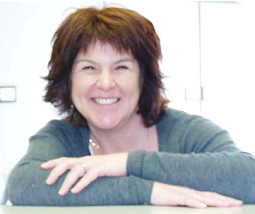Since arriving at the Carlyle Primary Health Clinic in 2007, Jean Daku has made patient needs the basis for her practice, collaborating with practitioners from other disciplines and equipping herself with the training and tools to meet those needs.
“Shared care is a huge benefit,” says Daku. “I can give you medications, I can talk to you, but I’m not a counsellor, or a social worker, or a mental health worker. It’s much better if patients can deal directly with these people on those kinds of issues.”
Daku has consistently moved beyond the “solo practitioner” model of care. One of her first initiatives in Carlyle was to establish an interdisciplinary clinic for people living with diabetes. Twice each month, patients can come to the clinic and access the care and counsel of a diabetic educator, a dietitian, and Daku herself, all under the same roof.
“They can get everything at once,” Daku says. “If they need prescriptions, I can provide them, if they need to talk about their diet, they can do that.”
Wanda Miller, Sun Country Health Region’s director of primary health care, has worked with Daku since 2007 when the Carlyle Medical Clinic made its transition to a primary health care site. What sets Daku apart, says Miller, is her capacity to build relationships with patients and all team members. “She sees the value in everyone and understands the roles and responsibility that each player brings to enhance patient care. The right person at the right time for the right situation is very well understood by Jeannie.”
The diabetic clinic was Daku’s first foray into team-based care. Yet in her 25 years as a registered nurse, she had seen countless instances of the connection between patients’ physical and emotional well-being. When she signed on for the Health Quality Council’s most recent Chronic Disease Management Collaborative, she was drawn to its resources for identifying and helping patients dealing with depression.
“I saw it as a great learning opportunity and a chance to help people,” she says.
Newly equipped with depression assessment and support tools, Daku immediately set to work adopting and adapting them for her patients at the clinic. And once again, she took an interdisciplinary approach, arranging for weekly clinic visits by a psychiatrist and a mental health nurse.
“Our physician is also involved in all the care we do, and I meet with a social worker once a month so we can discuss how our patients are doing,” she says.
Although people living with chronic diseases often experience depression, the condition can easily go undiagnosed and untreated.
“I can touch your stomach and know if you’re experiencing pain,” Daku says. “But how do I know if you’re depressed just by looking at you?”
To address this gap, Daku has adapted the PHQ9 health questionnaire, a standard assessment tool for patients undergoing a physical. Daku’s questionnaire now includes two questions that can point to depression in a patient.
Daku makes use of algorithms that help her determine what the next care steps should be for a depressed patient. She also has her patients’ charts colour-coded so that those dealing with depression are allotted 40 minutes, rather than the usual 20, when they call in to book an appointment.
Miller says Daku’s passion for patient-centred, team-based care has made believers of many of her colleagues.
“When we first talked about running clinic days, everybody said, ‘You can’t do that, that’s patient-slot time, we have to put these patients through,'” Miller recalls. “Today they’re right on board.”
For her part, Daku is quick to credit her colleagues for their willingness to practice care collaboratively. She also says interdisciplinary care is easily achievable for any practitioner who sees the benefits.
“All you have to do is look around and see what other health professionals are doing, and how they could help your patients, and you can really do wonders,” she says.
Since arriving at the Carlyle Primary Health Clinic in 2007, Jean Daku has made patient needs the basis for her practice, collaborating with practitioners from other disciplines and equipping herself with the training and tools to meet those needs.
“Shared care is a huge benefit,” says Daku. “I can give you medications, I can talk to you, but I’m not a counsellor, or a social worker, or a mental health worker. It’s much better if patients can deal directly with these people on those kinds of issues.”
Daku has consistently moved beyond the “solo practitioner” model of care. One of her first initiatives in Carlyle was to establish an interdisciplinary clinic for people living with diabetes. Twice each month, patients can come to the clinic and access the care and counsel of a diabetic educator, a dietitian, and Daku herself, all under the same roof.
“They can get everything at once,” Daku says. “If they need prescriptions, I can provide them, if they need to talk about their diet, they can do that.”
Wanda Miller, Sun Country Health Region’s director of primary health care, has worked with Daku since 2007 when the Carlyle Medical Clinic made its transition to a primary health care site. What sets Daku apart, says Miller, is her capacity to build relationships with patients and all team members. “She sees the value in everyone and understands the roles and responsibility that each player brings to enhance patient care. The right person at the right time for the right situation is very well understood by Jeannie.”
The diabetic clinic was Daku’s first foray into team-based care. Yet in her 25 years as a registered nurse, she had seen countless instances of the connection between patients’ physical and emotional well-being. When she signed on for the Health Quality Council’s most recent Chronic Disease Management Collaborative, she was drawn to its resources for identifying and helping patients dealing with depression.
“I saw it as a great learning opportunity and a chance to help people,” she says.
Newly equipped with depression assessment and support tools, Daku immediately set to work adopting and adapting them for her patients at the clinic. And once again, she took an interdisciplinary approach, arranging for weekly clinic visits by a psychiatrist and a mental health nurse.
“Our physician is also involved in all the care we do, and I meet with a social worker once a month so we can discuss how our patients are doing,” she says.
Although people living with chronic diseases often experience depression, the condition can easily go undiagnosed and untreated.
“I can touch your stomach and know if you’re experiencing pain,” Daku says. “But how do I know if you’re depressed just by looking at you?”
To address this gap, Daku has adapted the PHQ9 health questionnaire, a standard assessment tool for patients undergoing a physical. Daku’s questionnaire now includes two questions that can point to depression in a patient.
Daku makes use of algorithms that help her determine what the next care steps should be for a depressed patient. She also has her patients’ charts colour-coded so that those dealing with depression are allotted 40 minutes, rather than the usual 20, when they call in to book an appointment.
Miller says Daku’s passion for patient-centred, team-based care has made believers of many of her colleagues.
“When we first talked about running clinic days, everybody said, ‘You can’t do that, that’s patient-slot time, we have to put these patients through,'” Miller recalls. “Today they’re right on board.”
For her part, Daku is quick to credit her colleagues for their willingness to practice care collaboratively. She also says interdisciplinary care is easily achievable for any practitioner who sees the benefits.
“All you have to do is look around and see what other health professionals are doing, and how they could help your patients, and you can really do wonders,” she says.



